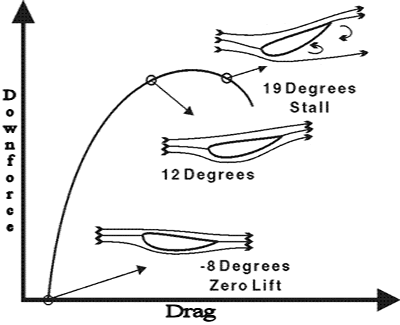F1 WINGS: BASICS
If you have already read the aerodynamics homepage you will understand how a basic F1 wing works. Here we will talk about the intricacies of it all.
You may be thinking, if downforce is produced by allowing the air to flow upwards off the wing, therefore pushing down the car. Then you can surely have more downforce by increasing the angle at which the wing is to the horizontal; forcing the air even more upwards. You would be right; up to a point.
Yes increasing the wing angle (known as the ANGLE OF ATTACK) does increase downforce but you can only increase it up to a CRITICAL ANGLE. Higher than this angle and the airflow will STALL. Let's now break down what this actually means.


However, F1 Engineers are not going to give up that easily. They wanted to find out how they could increase the angle of attack without separating the airflow from the wing. The answer: VORTICES
A vortex is a spiral of air (shown below & right) and is crucial to the aerodynamics of an F1 car. Essentially, it can be used to keep the airflow attached to a surface.

To the left you can see that if the angle of attack is to high then the air below it gets separated from the wing and does not follow it fully upwards. This is because the momentum of the air is too high for the air to move all the way up. By the time the air has started rising, it is already past the end of the wing. This is known as AIR FLOW SEPARATION and results in even less downforce than when the angle was smaller. This is where you have aerodynamic STALL. Instead of the nice laminar flow (in smooth layers) behind the wing you get TURBULENT flow (chaotic and messy).
The graph of angle of attack versus downforce is shown below and clearly depicts the decrease in downforce caused by stall.
However, it is also worth noting that an increased angle of attack also increases drag as the car is less streamlined. This results in less top speed on the straights. So a compromise must be made for tracks such as Silverstone and Spa which both have long straights but also fast, high downforce corners. Think Copse/Stowe at Silverstone and Les Combes/Pouhon at Spa. This gives F1 engineers a headache!

If a vortex can be induced where the air separates and it is spinning in the right direction, it can start to pull the airflow up towards the boundary of the wing. This would prevent stall and also increases downforce.
Vortices are not only used to keep air attached ot a wing but engineers use them all over the chassis.
For example, engineers want nice layered laminar airflow hitting the huge rear wing as this would generate the most downforce. However, to get to the rear wing the air must pass by the rest of the car first and sometimes the air gets separated from the body before it reaches the wing. This results in turbulent messy air hitting the wing instead.
How do we solve this. Vortices again. They are produced by VORTEX GENERATORS and F1 cars are covered with them. They are on all the wings and side-pods of an F1 car. See the Toro Rosso fins below. They help keep the airflow close to the boundary layer, increasing efficiency and promoting more downforce. See if you can spot them next time you watch Formula 1!
The inner tips of the front wing are also vortex generators (see 2020 AlphaTauri) which produce the y-250 vortex which is perhaps the most important aerodynamic phenomenon of the decade. And so it has its own page which you can find here: Front Wing & y-250 Vortex


